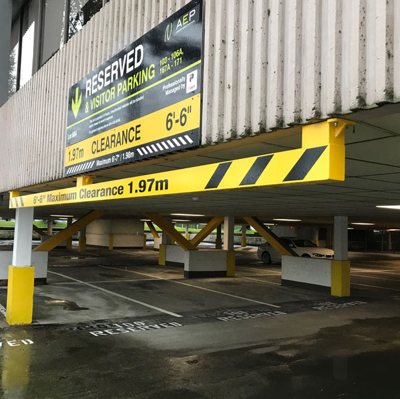A very important factor to consider when traveling with your car is the available parking space in your intended destination. You can't just park anywhere since local traffic laws and safety should always be considered. You don't want to end up with a parking violation or worse - get your car damaged or stolen just because you went to park anywhere.
This is the reason why using a parking garage is highly recommended when on the road. Built specifically to secure your vehicle from various elements, the amount paid to securely park your vehicle is more than enough to protect it from dangers and unnecessary parking violations.
 Parking Clearance Considerations
Parking Clearance Considerations
To securely park your car, it's very important to learn more about the parking space clearance. Fortunately, most pay-for-parking spaces offer helpful signs to prevent cars from getting stuck.
The most common clearance sign found in parking spaces is the height clearance. If you own a compact to full-size car, this should not be a big concern.
However, trucks and commercial vehicles should take note of this information because their vehicle could get stuck - preventing other vehicles from getting in or out of the parking garage.
Width Allocation
Other considerations for a parking garage is the width allocation for each vehicle. A comfortable width allocation for parking on most vehicles is at least 10 feet since this will allow the vehicle to park and open the doors without bumping into other vehicles. Due to build restrictions for vehicles, a vehicle width doesn't have to be extraordinarily wide.
Length
In terms of length, parking garages often provide up to 24 feet of depth to accommodate trucks with extended beds.
Turning Radius
One of the most important factors to consider in parking garages is the turning radius. Basically, this is the space required for a vehicle to safely turn without bumping into anything. Building engineers and planners consider this factor extremely important especially in multi-floor buildings since vehicles will be turning most of the time in order to arrive at their parking space.
For a parking space to accommodate most passenger vehicles, the turning radius should be at least 35 feet or 10.7 meters. Commercial trucks, similar large vehicles and those with larger than normal wheelbase will need a bigger turning radius.
Clearance Requirements For Some Popular Car Categories
Here are some clearance requirements for popular car categories:
Compact Cars (e.g., Toyota Corolla, Honda Civic):
- Height Clearance: 5-6 feet
- Width Clearance: 6-7 feet
- Length Clearance: 14-15 feet
Sedans (e.g., Toyota Camry, Honda Accord):
- Height Clearance: 5.5-6.5 feet
- Width Clearance: 6-7 feet
- Length Clearance: 15-17 feet
SUVs (e.g., Toyota RAV4, Ford Explorer):
- Height Clearance: 6.5-7.5 feet
- Width Clearance: 6.5-7.5 feet
- Length Clearance: 15-20 feet
Pickup Trucks (e.g., Ford F-150, Chevrolet Silverado):
- Height Clearance: 6.5-8 feet
- Width Clearance: 6.5-7.5 feet
- Length Clearance: 17-22 feet
Vans (e.g., Honda Odyssey, Ford Transit):
- Height Clearance: 7-9 feet
- Width Clearance: 6.5-7.5 feet
- Length Clearance: 17-20 feet
Commercial Trucks (e.g., Freightliner Cascadia, Kenworth T680):
- Height Clearance: 8-14 feet
- Width Clearance: 8-9 feet
- Length Clearance: 20-40 feet
Unforeseen Barriers
While a parking garage will advertise that their vehicle can be safely parked inside with ample space provided, a driver should always be careful with unforeseen barriers to ensure they can park with ease. For example, a parking garage can advertise a good clearance for most vehicles but it could be inaccessible if the parking garage door opener is not working properly. Other barriers such as signs, hanging lights could be a barrier for safe parking.
Conclusion
A good clearance is very important to park any type of vehicle. From height allocation to turning radius, everything should be considered to avoid unnecessary issues. Parking garages are designed to provide secure and organized spaces, but it's always wise to plan ahead and remain cautious about potential barriers.
